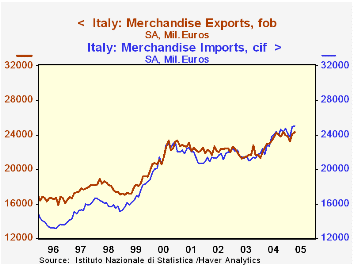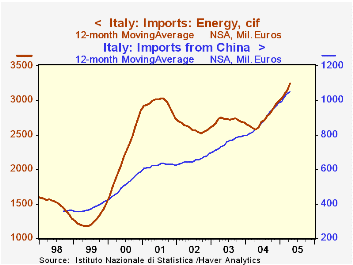 Global| Jun 16 2005
Global| Jun 16 2005Italy's Trade Accounts Shift to Deficit; Dynamics of Global Business Alter Long-Running Surplus Position
Summary
Foreign trade for Italy has swung from a comfortable surplus two years ago to a persistent and increasing deficit. The April figures, reported today, show a shortfall of 784 million following on March's 872 million. This [...]

Foreign trade for Italy has swung from a comfortable surplus two years ago to a persistent and increasing deficit. The April figures, reported today, show a shortfall of €784 million following on March's €872 million. This deterioration came despite notable increases in exports, amounting to more than a million euros in the past year, including double-digit yearly percentage gains in several recent months. Imports have obviously gone up more than exports, growing €2.2 billion in the past year. More significantly, the accompanying graph shows that Italy was traditionally in an overall surplus trade position, which reached as high as €3.6 billion in mid-1996.
As seen in the table below, energy is a major ingredient in the move to a trade deficit. The balance there was -€3.3 billion in April, €1.0 billion bigger than the year-ago amount and the largest in the history of these particular data, which go back to 1991.
But energy is not the only factor. Similar shifts have occurred in intra-Euro-Zone trade, which illustrates the result of growth in imports that outstrips growth in exports. Also, in non-Euro countries, the trade position with China is moving gradually toward a larger deficit. This latter is a more modest phenomenon, but it contrasts distinctly with the experience elsewhere in Asia: trade with Japan is moving to smaller deficits as imports from there tend downward irregularly. Trade with Asian NICs remains generally in modest surplus, with the occasional monthly deficit. Trade with other regions, such as the United States, seems to be maintaining former patterns.
These changes toward a trade deficit for Italy are not of great magnitude. But the move to persisting deficit for a nation long in surplus is notable. It highlights some key sensitivities in today's global economy: energy imports and merchandise flows from China. At the same time, it also highlights the increasing volume of two-way trade with neighboring nations. These patterns are likely to be hallmarks of every nation's business in the days ahead.
| Italy (SA, Millions of €) |
Apr 2005 | Mar 2005 | Apr 2004 | Monthly Averages|||
|---|---|---|---|---|---|---|
| 2004 | 2003 | 2002 | ||||
| Balance | -784 | -872 | +183 | -126 | +229 | +735 |
| Exports | 24,282 | 24,086 | 23,048 | 23,391 | 21,721 | 22,153 |
| Imports | 25,066 | 24,958 | 22,865 | 23,517 | 21,491 | 21,418 |
| Balance on Energy (NSA) | -3,258 | -2,976 | -2,221 | -2,438 | -2,209 | -2,203 |
Carol Stone, CBE
AuthorMore in Author Profile »Carol Stone, CBE came to Haver Analytics in 2003 following more than 35 years as a financial market economist at major Wall Street financial institutions, most especially Merrill Lynch and Nomura Securities. She had broad experience in analysis and forecasting of flow-of-funds accounts, the federal budget and Federal Reserve operations. At Nomura Securities, among other duties, she developed various indicator forecasting tools and edited a daily global publication produced in London and New York for readers in Tokyo. At Haver Analytics, Carol was a member of the Research Department, aiding database managers with research and documentation efforts, as well as posting commentary on select economic reports. In addition, she conducted Ways-of-the-World, a blog on economic issues for an Episcopal-Church-affiliated website, The Geranium Farm. During her career, Carol served as an officer of the Money Marketeers and the Downtown Economists Club. She had a PhD from NYU's Stern School of Business. She lived in Brooklyn, New York, and had a weekend home on Long Island.





